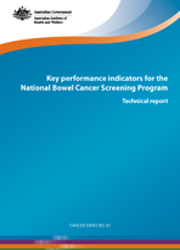Summary
Cancer contributes significantly to the burden of illness in the Australian community. Bowel cancer is one of the most significant cancer types in terms of incidence and mortality. In 2010, 14,860 people were diagnosed with bowel cancer and in 2011 there were 3,999 deaths from the disease. Screening for bowel cancer is available in Australia through the National Bowel Cancer Screening Program (NBCSP), which aims to reduce the incidence, illness and mortality related to bowel cancer through screening to detect cancers and pre-cancerous lesions in their early stages, when treatment is most successful.
Reporting statistics about the NBCSP in a standardised way is vital to ensure that governments, researchers and health workers have access to relevant and reliable statistics about the performance of the program over time. This report describes the National Bowel Cancer Screening Program Performance Indicator Set (NBCSP PIs) and is a reference tool for anyone who wishes to understand, measure and report the progress of bowel cancer screening in Australia.
The indicators were developed by the National Bowel Cancer Screening Program Report and Indicator Working Group (the working group) and have been endorsed by the Standing Committee on Screening, the Community Care and Population Health Principal Committee, the National Health Information Standards and Statistics Committee and the National Health Information and Performance Principal Committee. The indicators are consistent with the five Australian Population Based Screening Framework (PBSF) steps of recruitment, screening, assessment, diagnosis and outcomes.
This report outlines both the development process and the technical specification for the 11 agreed indicators that are part of the NBCSP PIs. This report also identifies data sources and any future data development.
| PBSF step | PBSF aim | NBCSP performance indicator |
|---|---|---|
| Recruitment | Targeted population encouraged to participate in screening | 01—Participation rate |
| Screening | Targeted population who participate in screening | 02—Screening positivity rate |
| Assessment | Screened population who require further assessment | 03—Diagnostic assessment rate |
| 04—Time between positive screen and diagnostic assessment | ||
| Diagnosis | Assessed participants diagnosed with the condition | 05a—Adenoma detection rate |
| 05b—The positive predictive value of diagnostic assessment for detecting adenoma | ||
| 06a—Colorectal cancer detection rate | ||
| 06b—The positive predictive value of diagnostic assessment for detecting colorectal cancer | ||
| 07—Interval cancer rate | ||
| 08—Cancer clinic-pathological stage distribution | ||
| Outcomes | Reduced morbidity and mortality from the condition | 09—Adverse events—hospital admission |
| 10—Incidence of colorectal cancer | ||
|
11—Mortality from colorectal cancer
|
Preliminary material: Acknowledgments; Abbreviations
1 Introduction
- Measuring performance through indicators
- The National Bowel Cancer Screening Program
- Development of NBCSP performance indicators
- Data limitations
2 Indicators
- Overview of the performance indicators
- PI 01-Participation rate
- PI 02-Screening positivity rate
- PI 03-Diagnostic assessment rate
- PI 04-Time between positive screen and diagnostic assessment
- PI 05a-Adenoma detection rate
- PI 05b-Positive predictive value of diagnostic assessment for detecting adenoma
- PI 06a-Colorectal cancer detection rate
- PI 06b-Positive predictive value of diagnostic assessment for detecting colorectal cancer
- PI 07-Interval cancer rate
- PI 08-Cancer clinico-pathological stage distribution
- PI 09-Adverse events (hospital admission rate)
- PI 10-Colorectal cancer incidence rate
- PI 11-Colorectal cancer mortality rate
Appendixes
Appendix A: National Health Performance Committee indicator guidelines
Appendix B: Reviewed indicators
Appendix C: Classifications
Appendix D: NBCSP Report and Indicator Working Group members
End matter: References; List of tables



